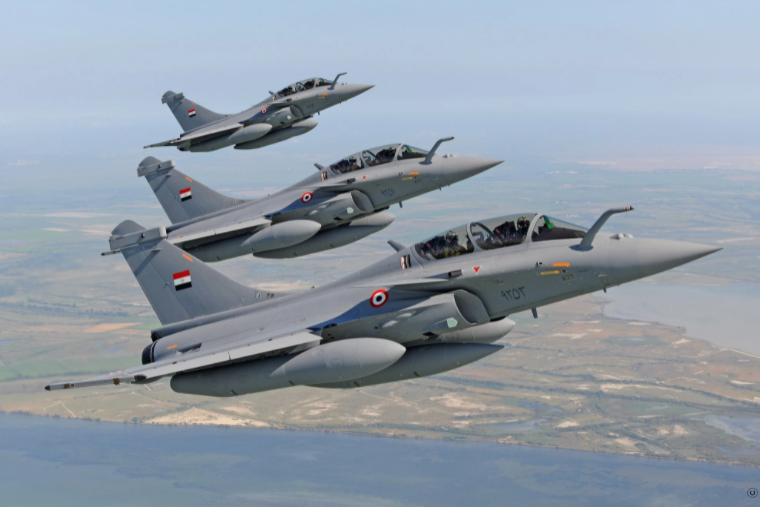
Rafale Jets for Egypt’s Air Force (Dassault Aviation)
BEIRUT: Egypt’s $4.5 billion for 30 new Rafale jets will buy not just more of the French jets, but should improve data sharing across the Mideast powerhouse’s fleet.
Egypt and France’s contract to provide additional jets to Cairo’s Rafale fleet makes it the second-biggest fleet in the world after France, with 54 of the fighters.
Egypt will receive the F3-R version of the Rafale. Its updated software will allow integration of advanced systems including Thales’ Talios new-generation laser designator pod, MBDA’s impressive Meteor long-range air-to-air missile and the laser homing version of the Safran AASM air-to-ground modular weapon.
This may not be the last Rafale purchase. Egyptian sources tell Breaking Defense that Egypt is now eying the F4. “We are looking to increase the number to 72 or 100 units, depending on Egypt’s financial capacity,” they told me. “The new F4 version will have enhanced radar capabilities, and new weapon systems including smart gliders, heavier versions of the AASM Hammer precision-guided munitions and updated MICA NG missiles.”
Validation of the F4 standard is planned for 2024, with some functions coming in 2022. The F4 will include a new predictive maintenance tool known as the prognosis and diagnostic aid system. Other maintenance optimization features are scheduled, particularly with solutions based on big data and artificial intelligence.
“This new order is proof of the unfailing bond that unites Egypt, the first foreign user of the Rafale, as it was for the Mirage 2000, with Dassault Aviation for nearly 50 years,” Eric Trappier, Chairman and CEO of Dassault Aviation said in a statement on May 4. “It is also a tribute to the Rafale’s operational quality, as this is the second time an export customer has chosen to order additional aircraft.”
The order will be financed through a 10-year loan, with the first aircraft delivered three years after the contract takes effect. The estimated cost is $4.5 billion, including associated equipment from French companies MBDA and Safran worth another $240 million, according to the “Disclose” investigative website.
Data Sharing
Military experts believe the new Rafale will improve data sharing with American, Russian, and other European aircraft in service with the Egyptian Air Force.
Military researcher and defense analyst at the Arab Forum for Policy Analysis in Cairo Mohammad Al-Kenany noted that Dassault Aviation provides the ability to integrate different data links, including for Non-NATO allies, an important aspect for Egypt who operates platforms from different origins.
Things do not look complicated for Russian Mig-29 and Su-35 aircraft either.
“The process of linking, exchanging, and sharing data will happen through the ground command and control centers, by receiving and indirectly sharing data between the fighters, various combat platforms and the command-and-control system,” he said, given that these platforms operate within the scope of the ground command and control network.
“If this happens, data sharing between Western and Eastern aircraft will highly increase,” he told me. “Not only will this improve jam resistance and situational awareness, but also increase data throughput and capacity of information exchange.”
The F3R Rafale aircraft has a new and more advanced data link able to exchange information and images with different types of fighters and aircraft. “The aircraft will also be fitted with a new satellite link that increases the operational range of data transfer with the ground command and control stations and monitor all changes through long-range air operations,” he added.
For Western-made fighters, data sharing for Egypt is easy as fighters “carry unified Link-16 tactical data links or connect through early warning platforms currently in service with the Egyptian Air Force, such as E2C Hawkeye AEW & C.
To do so, Egypt relies on its indigenous Radar Integration and Surveillance Center (RISC2), an integrated system that jointly undertakes the tasks of battle management, command and control of air defense and air force units as well as gathering, analyzing and sharing data.
Also, Egypt recently launched Tiba-1 satellite that will be serving both the military communications network and armed forces command and control network while facilitating the process of exchanging data for analysis.
What The Deal Represents
The deal clearly represents a huge leap ahead for Dassault Aviation’s Rafale production line.
“This agreement heavily supports the French military industry in general, and the Rafale’s production line till after 2026 in specific” Al-Kenany said, creating the equivalent of 7,000 jobs in France over three years.
To the Egyptian army, the new fighters will add unique features to the Air Force deterrence capabilities on both tactical and strategic levels.
“The new number of Rafale jets gives the Air Force a bigger capacity to perform precise surgical strikes and access hostile depths, enhancing air sovereignty and reinforcing the Egyptian deterrence system,” Mohamad Hassan, researcher and defense analyst at the Egyptian Center for Strategic Studies explained. “With an operational range of 1,850 km, the Air Force will now be able to counter bigger threats within its strategic field,” he added.
The deal is also a clear message to the US.
“After the US rejected Egypt’s request to acquire 20 F-35 jets back in 2019, Cairo had to look for a fighter with technologies closer to the fifth generation,” Al-Kenany said. “The Air Force still needs to complete its development plans, and with the lack of any American imminent action to develop the existing F-16 fleet, the new fighters will compensate for what we need.”
China’s new H-20 stealth bomber ‘not really’ a concern for Pentagon, says intel official
“The thing with the H-20 is when you actually look at the system design, it’s probably nowhere near as good as US LO [low observable] platforms, particularly more advanced ones that we have coming down,” said a DoD intelligence official.


























